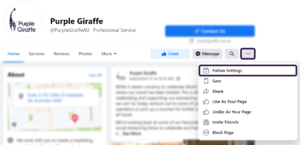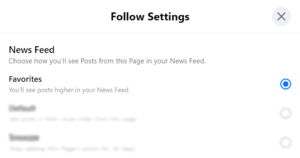Welcome back to our blog series on developing and implementing an effective social media strategy. Last week we established the importance of an active and appropriate social media presence, and discussed creating a plan that encompasses and considers the relevant audience, competitors, and social media platforms. This week we continue by focussing on the content you post, and how it can be best adapted to your goals.
Step 5: Get clear on content
It’s important to have a plan for executing your social media strategy – this is what will bring it to life.
They say “Content is King” and knowing your goals and your audience will help you get clear on content.
We suggest identifying three to five key themes that support your objectives, and regularly and consistently posting high quality content that support those themes.
It is important for content to have a consistent voice, tone and style that is on-brand and for content to be:
- Authentic – reflecting your brand personality
- Unique – using original images and video (as opposed to stock images) and creating your own high-quality content helps it stand out
- Quality – making sure that the images are high quality and formatted for the platform dimensions
Before posting, always ask yourself – does this content achieve our mission for this platform? There are no hard and fast rules on this, but just be aware it may not necessarily suit to post the same content across all platforms. It’s perfectly okay to do it – or not do it – as long as it aligns with your objectives for the platform.
For example, if your audience on LinkedIn is quite different to your audience on Instagram, an article you share on Linked In may not have a place on Instagram – so it’s worthwhile doing a quick check and only post content that aligns with your mission for the platform. Consistently posting content that doesn’t align with your audience on that platform may mean decreased engagement which means decreased organic visibility.
For efficiency, it is also important to plan a schedule of activity or a social media content calendar so you’re not wasting time scratching around each day to come up with content to post. Spend some time identifying the key campaigns, messages or events you need to communicate during the year – special events, industry awards, new product launches, etc. and make sure they’re included in your schedule.
Once you’ve planned out your posts for the next month, you can also schedule them in advance on Creator Studio or other third-party platforms like Hootsuite or Sprout to make sure your social media plans are actually activated.
Although most social media platform algorithms penalise pre-scheduled posts (meaning they are displayed in fewer newsfeeds organically), being active on social media is still important for people visiting your page before they visit your website – it is part of the social validation and remember, 60% of people do this.
Scheduling posts involves a slight trade-off. Scheduling makes sure you’re posting consistent, planned content regularly, but it is also a good idea to post natively directly to the platform from time to time where you can too to maximise organic reach.
Pro tip:
Even if your key objective is sales, no one likes to be sold to all the time… and especially not on social media. Social media is an opportunity for people to get to know you and your brand and for you to build the ‘know, like and trust’ factor – not purely push your products or services.
A strong rule of thumb for social media is the 80/20 Rule:
- 80% of posts should be to inform, educate, entertain or engage your audience
- 20% should directly promote your brand or sell, with a call to action
As you build awareness and loyalty with your followers, you can progress to the Rule of Thirds:
- 1/3 of your content promotes your business, leads and generates sales
- 1/3 shares value add content such as ideas and stories from thought leaders or like-minded businesses
- 1/3 shares personal interactions with your audience
Maximising organic reach – the DOs:
To maximise organic reach there are four ranking signals Facebook uses to determine how many people see your posts organically (free of charge, without you paying for it). You should be aware of the ranking signals, so you can leverage them to maximise your organic reach.
The ranking signals include:
- How long your page has been active on Facebook
- The percentage of followers engaging with your posts and page in general (liking, commenting, sharing, reviewing, visiting, etc.)
- Consistency and frequency of posts
- How actively the business page engages with its audience – that is responsiveness to comments and messages
There are a few things you should do to maximise organic reach:
- Create engaging content
- Create relevant, inspiring, positive, funny content
- Create posts that users will want to share – positive content, posts that make them the ‘first to know’, etc.
We call these thumb-stopping moments – the posts that capture your audience’s attention enough to cause their thumb to stop scrolling through the newsfeed. This is often achieved with a great headline, eye-catching image, or video.
- Create quality content
- Videos – make them minimum 3 minutes long
- Images – high quality unique
- Text only posts can also be attention grabbing when the Facebook newsfeed is saturated with pictures
- Post regularly at high traffic times
Know when to post for your audience. Facebook recommends posting at least once a day, and at the same time of day each day for best results. Check your analytics to determine when your audience is active on social media and plan to post at those times. Post when you are able to engage and respond to comments.
Reported optimal times according to Hootsuite are:
- B2B – 9am to 2pm, Tuesday, Wednesday and Thursday
- B2C – 12pm on Monday, Tuesday and Wednesday
- Build engagement & interactions
- Get your family and friends to regularly engage with your page to increase visibility
- Ask them to like, comment, and share your posts
- The rest of your audience will then join the conversation too
Focus on timely interaction – make sure you reply to comments and messages within 24 hours, and remember social media is a two-way conversation, so be sure to acknowledge and engage with your audience.
Pro tip:
Inform your followers to ‘Favourite’ your page. Make sure your audience knows they can add your page as a ‘Favourite’ to ensure it is prioritised in their newsfeeds.


Maximising organic reach – the DON’Ts
To maximise performance of organic content on social media and make sure your posts are not penalised by the algorithms, there are a few key things to avoid:
- Posts created for the sole purpose of pushing people to buy a product or service
- Social media accounts that are totally product or sales focused, as they don’t perform well organically on social media
- Posts that push people to enter promotions to giveaways
- Click bait – is again penalised by the platforms
- Platforms recognize key words in posts such as ‘free’, ‘competition’, ‘tag’ etc and penalize the organic placement and reach
- Posts or any activity that links to outbound or off-platform content (so don’t use links to websites on every post)
Including links to external websites in posts isn’t viewed favourably by Facebook as they want to keep people on the platform so they won’t show your audience posts that encourage people to leave it to go to another site by including a URL. You should therefore consider linking to on-platform events, etc., or using click throughs as part of paid campaigns.
Pro tip:
While planning is important – a social media strategy is definitely not ‘set and forget’. Social media is a two-way conversation. Don’t just schedule out all your posts and do nothing else for the rest of the month. Engaging with your audience on social media cannot be underestimated.
Commenting on relevant posts from other pages, businesses or people will help build your brand and visibility and even more importantly acknowledging and replying to comments on or messages to your business pages is a crucial but often underutilized tool. Be sure to set up a process for managing this and allocate time or resources to it – a universal inbox (available on most scheduling platforms) can be a good start.
Step 6: Balance organic and paid activity
Whilst each of the social media platforms are essentially ‘free’, there is increasingly an element of ‘pay to play’. Therefore, we recommend a strategy which combines organic and paid social media activity.
Even if you are doing everything right in terms of optimising organic content on Facebook – posting awesome content at the right times, engaging with your audiences, using new functionality, etc. – organic (free) reach is continuing to decline.
Estimated reach for organic posts is only around 1.2-2% of your audience, down from 5% in 2015. And that’s IF you’re doing everything perfectly!
It’s said that on average there are around 1,500 posts that could appear in a user’s newsfeed, but the algorithms are designed to show users what the platform thinks is the highest quality content, to try to keep users on the platform. So users typically only see around 300 (20%) of the potential 1,500 posts that they could see.
Given the decline in organic reach, you can’t rely on free activity alone to reach your ideal audience, so most business users are finding it necessary to supplement their organic activity with a paid social media strategy.
The algorithm changes aren’t all bad, because increased user satisfaction with the platforms means people will spend more time there. So how do you balance organic activity with some paid activity? By leverage low cost ads, and building an effective sales funnel/nurturing sequence.
Developing a paid social media strategy follows essentially the same strategy formula we’ve been stepping through here:
- Identifying the right objective is a crucial foundation to setting up the campaign properly
- Know why you’re doing it, what you want to achieve (do you want to increase followers on the platform, drive traffic to your website, or generate leads or sales conversions?)
- Clearly identify your audience – target people with the means and motivation to buy. Set up multiple ad sets instead of lumping all of the characteristics into one – it’s proven to be more effective and it will make it easier for you to see what’s working and what’s not
- Constantly review even throughout the campaign – as always, don’t set and forget. The first 48 hours provide a solid indication of performance – make adjustments or tweaks as you go and switch off ads that are not working.
- Evaluate performance to tweak for improvement.
Ads can also help increase organic reach. Ad campaigns can drive people to your posts and page, and people spending time on your page also helps with increasing organic reach as well. Facebook is also limiting ads for larger businesses, freeing up opportunities for smaller businesses, making ads slightly more affordable.
Pro tip #1:
Don’t be tempted to boost posts as part of your paid strategy. Resist the Boost Button – it may seem simple, but it is inadequately targeted, and consequently has very low conversion and won’t deliver the results you want.
Pro tip #2:
Depending on your offering, functionality such as Facebook Groups may be quite beneficial for organic (unpaid) activity as statistics show that organic reach for Groups is around 6.5%, which is much better than the 1-2% for posts.
Similar results have also been seen for LinkedIn as well.
Researching the best platform and the best features to use can make a big difference to your results.
Step 7 – Evaluate Performance
At the outset, we acknowledged the importance of knowing your goals and objectives – it’s just as important to know how you’re going with them. Monitoring performance metrics and KPIs, and regularly reviewing your strategy and activity is crucial to using social media like a professional.
Despite best laid plans, it is unrealistic to expect you will get everything right the first time – even professionals are constantly monitoring and tweaking their activity on social media to optimise performance. Some strategies won’t work, and some will work better than expected. So as the data starts to grow, review it and use it to re-evaluate your strategies and amend them as needed.
It can also be helpful to ask for feedback on your activity – you can ask your customers or colleagues directly or include questions in consumer feedback surveys, if you do them.
Pro tip:
Social media moves at a fast pace. Platforms evolve and change and introduce new functionality frequently. New platforms also emerge from time to time, so it pays to be across industry developments.
Often ‘early adopters’ can be rewarded for being amongst the first to take up new offerings. For example, building audiences organically on new platforms is typically easier.
Existing platforms also reward people for using new functionality such as Instagram’s new ‘Reels’ capability, and even Stories and IGTV have greater visibility than regular posts. But as always, before diving in, be sure to ask yourself if it aligns with your brand and audience and what purpose it serves for you.
Evaluate & Assess
It is important to have meaningful metrics which clearly align with and measure performance against your goals. This table demonstrates how to align your social media goals and appropriate metrics with your overall business objectives. Vanity metrics such as followers and likes are easy to track, but it’s hard to quantify their true value.

Depending on your objectives – more meaningful measures may include engagement, click-through rates and conversion rates and objectives may be different depending on the platform and your intended goals for that platform.
For example, you may want to drive traffic to your website from LinkedIn, so click through rates will be important, whereas you may be using Instagram for brand awareness so reach or story views may be important. Monitoring performance metrics and regularly reviewing your strategy and activity is a crucial part of managing your social media like a professional.
Recapping the seven steps
To recap this series of blogs – firstly we went through some global social media statistics, which highlight why social media is an important consideration in your marketing and communications strategy.
We then stepped through the seven steps to developing and implementing an effective social media strategy – including some dos and don’ts of leveraging the algorithms to maximise organic reach, and a handful of pro tips to take your social media to the next level.
Despite being a heavily involved game of trial and error, developing and implementing an effective social media strategy remains crucial to achieving your business’s goals and objectives. It nevertheless remains possible to do, and to do well.
Hopefully, this series has offered a few golden hints and you will take away some practical tips which you can implement in your own business to help your social media efforts flourish.







